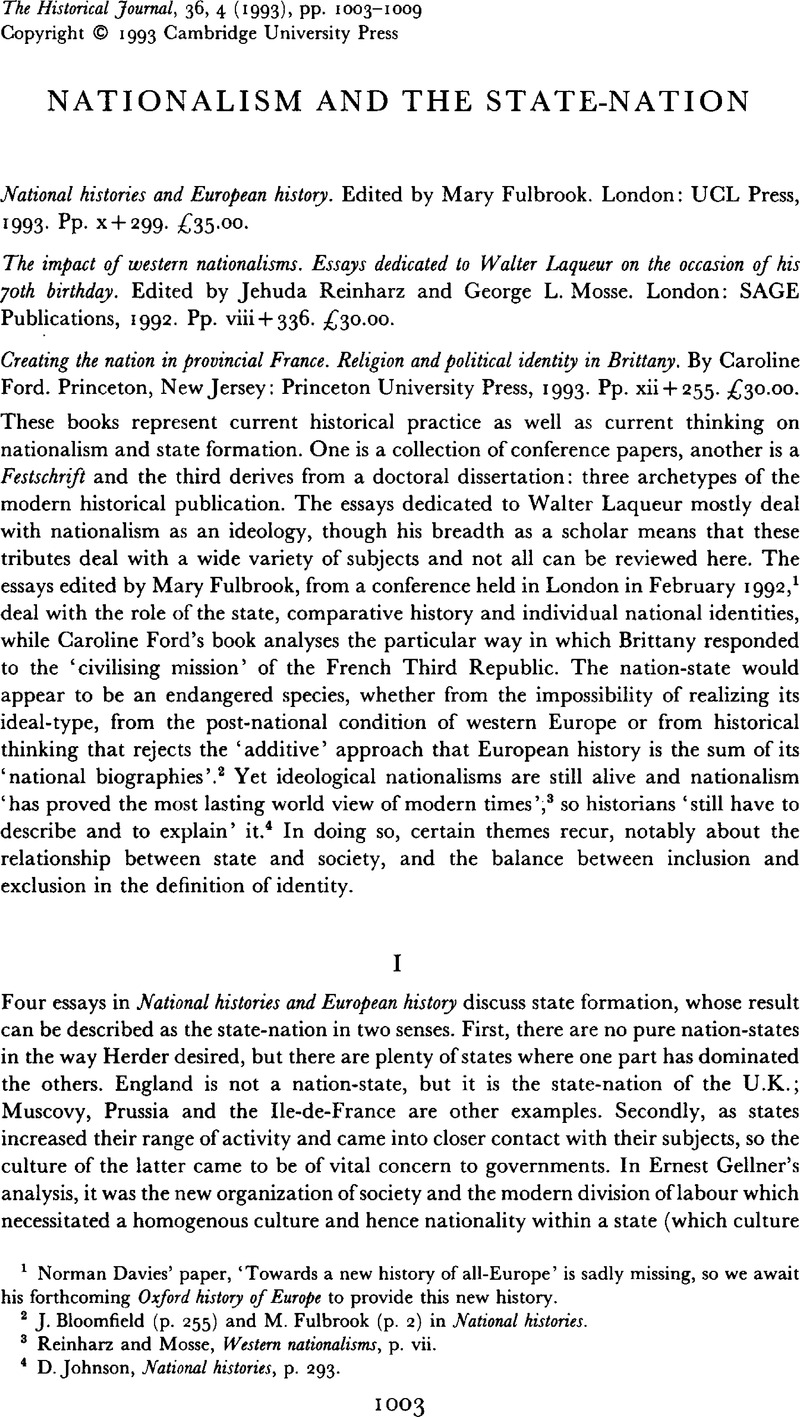No CrossRef data available.
Published online by Cambridge University Press: 11 February 2009

1 Norman Davies' paper, ‘Towards a new history of all-Europe’ is sadly missing, so we await his forthcoming Oxford history of Europe to provide this new history.
2 Bloomfield, J. (p. 255) and Fulbrook, M. (p. 2) in National historiesGoogle Scholar.
3 Reinharz, and Mosse, , Western nationalisms, p. viiGoogle Scholar.
4 Johnson, D., National histories, p. 293Google Scholar.
5 Gellner, E., Nations and nationalism (Oxford, 1983)Google Scholar.
6 Axtmann, R., ‘The formation of the modern state: the debate in the social sciences’, National histories, pp. 21–45Google Scholar, quotations from pp. 25 and 39.
7 With apologies to Dr Breuilly, who may well not agree with this treatment.
8 ‘Sovereignty and boundaries: modern state formation and national identity in Germany’, ibid. pp. 94–140, quotations from pp. 97–8 and 104 (original italics).
9 C. Emsley, ‘Peasants, gendarmes and state formation’, ibid. pp. 69–93, quotations from p. 84.
10 L. Riall, ‘Elite resistance to state formation: the case of Italy’, ibid. pp. 46–68.
11 M. Rady, ‘Core and periphery: eastern Europe’, ibid. pp. 163–82, quotation from p. 167.
12 D. Geary, ‘Working-class identities in Europe, 1850–1914’, ibid. pp. 204–15.
13 J. Morris, ‘Towards a European history of the petite bourgeoisie’, ibid. pp. 183–203.
14 J. Bloomfield, ‘The New Europe: a new agenda for research?’, ibid. pp. 255–84.
15 Melman, B., ‘Claiming the nation's past: the invention of an Anglo-Saxon tradition’, Western nationalisms, pp. 221–41Google Scholar.
16 Stephenson, J., ‘Britain and Europe in the later twentieth century: identity, sovereignty, peculiarity’, National histories, pp. 230–54Google Scholar.
17 M. Swales, ‘The peculiarities of national cultures: the German case’, ibid. pp. 216–29; quotation from p. 217.
18 Yahil, L., ‘National pride and defeat: a comparison of Danish and German nationalism’, Western nationalisms, pp. 99–124Google Scholar; quotation from p. 100.
19 M. Confino, ‘Solzhenitsyn, the west, and the new Russian nationalism’, ibid. pp. 257–82, quotations from pp. 264 and 275.
20 Bracewell, W., ‘National histories and national identities among the Serbs and Croats’, National histories, pp. 141–60Google Scholar.
21 Avineri, S., ‘Marxism and nationalism’, Western nationalisms, pp. 283–303Google Scholar.
22 B. Lewis, ‘Watan’, ibid. pp. 169–79.
23 B. Rubin, ‘Pan-Arab nationalism: the ideological dream as compelling force’, ibid. pp. 181–97.
24 G. L. Mosse, ‘The Jews and the civic religion of nationalism’, ibid. pp. 319–29.
25 Y. Shavit, ‘The “glorious century” or the “cursed century”: fin-de-siècle Europe and the emergence of modern Jewish nationalism’, ibid. pp. 199–220.
26 P. Mendes-Flohr, ‘Rosenzweig and the Kameraden: a non-Zionist alliance’, ibid. pp. 31–48.
27 Though pedants might prefer more accurate proof-reading: Jaurès appears as Jaurés (pp. 125, 251), de Galliffet as de Gallifet (pp. 135, 137), de Mun is first elected in 1893 and 1894 (pp. 97, 126), the 1898 elections are implied to be in 1899 (p. 135) and Maurras is credited with the foundation of Action Française instead of Vaugeois and Pujo (p. 185).
28 See for example Pierrard, P., Juifs et catholiques français (Paris, 1970), pp. 116, 119–21Google Scholar and Birnbaum, P., ‘Nationalisme à la française’, Pouvoirs, LVII (1991), 55–69Google Scholar or Anti-semitism in France (Oxford, 1992), especially pp. 113–115Google Scholar.